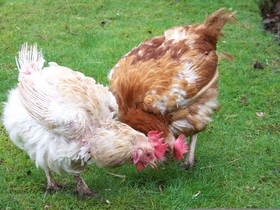 Brigit and Bunty Goodchicken discover their first worm!
Brigit and Bunty Goodchicken discover their first worm!
Hen Behaviour FAQs
The Pecking Order: This can seem quite a brutal process, I hate it, but too much human intervention can sometimes prolong it. There are, however, a few things that you can do to help it along:
Generally your hens will settle down quite quickly, alliances will form and some will develop into friendships.
Integrating Hens: New girls need to be integrated slowly to an established flock and ideally you have more new girls than old but this is not always possible. If you have only one hen it is very difficult to integrate her but not impossible, provided you give it enough time, patience and love.
Ideally you need to have a separate coop and run or area of the garden for your new hens where they can see the old girls through a fence. They will need to be settled in just as your original girls were. They need to recover their fitness and grow in confidence.
So allow them time to see each other through the fence and get used to the sight of each other. After a couple of weeks you can bite the bullet
and let them all in together to see what happens. Always do this under supervision, especially if you have a weaker hen or an obvious bully!
You can also put them all in the coop together at night when everyone is asleep. In theory everyone wakes up together, smelling the same, are
suitably confused and get along.
If you have one particular bully you can apply the same trick as before, by isolating her.
I have found a slowly, slowly approach works best for me. After their initial few weeks’ isolation, allow the girls to all mix in a large area for a short time. This allows any picked on hens to escape trouble. Supervise this (it is best to do this when you have a weekend or a few days off). Slowly
increase their time together until you are happy everyone is calm. I leave both coops open for a while so the new girls have a refuge at night but once I am happy harmony is reigning I let them all go to bed together in one coop.
I have integrated many flocks, and sometimes just one girl into an established flock and this has been the most successful method for me and my
girls.
The Pecking Order: This can seem quite a brutal process, I hate it, but too much human intervention can sometimes prolong it. There are, however, a few things that you can do to help it along:
- Pop them all in the coop together when they are asleep, so that they wake up together.
- Put Vaseline on the combs of all the hens so the dominant hen can’t get a grip. Chickens are attracted by blood so you want to avoid that.
- Make sure there are plenty of feeders and drinkers around so the dominant hen doesn’t hog them.
- Hang up some tasty greens for them to peck at to keep them occupied.
- Sometimes a human finger tapped (gently but firmly) on the back of the bossier hen can establish you as top chicken. This isn’t 100% successful, but worth a shot!
- Use your anti-peck spray to cover any bleeding patches or sore red bits.
Generally your hens will settle down quite quickly, alliances will form and some will develop into friendships.
Integrating Hens: New girls need to be integrated slowly to an established flock and ideally you have more new girls than old but this is not always possible. If you have only one hen it is very difficult to integrate her but not impossible, provided you give it enough time, patience and love.
Ideally you need to have a separate coop and run or area of the garden for your new hens where they can see the old girls through a fence. They will need to be settled in just as your original girls were. They need to recover their fitness and grow in confidence.
So allow them time to see each other through the fence and get used to the sight of each other. After a couple of weeks you can bite the bullet
and let them all in together to see what happens. Always do this under supervision, especially if you have a weaker hen or an obvious bully!
You can also put them all in the coop together at night when everyone is asleep. In theory everyone wakes up together, smelling the same, are
suitably confused and get along.
If you have one particular bully you can apply the same trick as before, by isolating her.
I have found a slowly, slowly approach works best for me. After their initial few weeks’ isolation, allow the girls to all mix in a large area for a short time. This allows any picked on hens to escape trouble. Supervise this (it is best to do this when you have a weekend or a few days off). Slowly
increase their time together until you are happy everyone is calm. I leave both coops open for a while so the new girls have a refuge at night but once I am happy harmony is reigning I let them all go to bed together in one coop.
I have integrated many flocks, and sometimes just one girl into an established flock and this has been the most successful method for me and my
girls.

